In the previous tutorial, we have seen about Band Pass Filter, a circuit which allows a certain band of frequencies of the signal to pass. In this tutorial, we will learn about Band Stop Filter, a filter with exact opposite functionality of a Band Pass Filter.
A Band Pass or Band Reject Filter stops or attenuates a band of frequencies while the frequencies outside this range are passed. The attenuated frequencies range is known as Stop Band.
If you are looking for information on Low Pass or High Pass filters, read the tutorials on Passive High Pass RC Filters, Passive Low Pass RC Filters, Active High Pass Filter and Active Low Pass Filter.
Introduction
The band stop filter is formed by the combination of low pass and high pass filters with a parallel connection instead of cascading connection. The name itself indicates that it will stop a particular band of frequencies. Since it eliminates frequencies, it is also called as band elimination filter or band reject filter or notch filter.
Following image shows the block diagram of a Band Stop Filter.
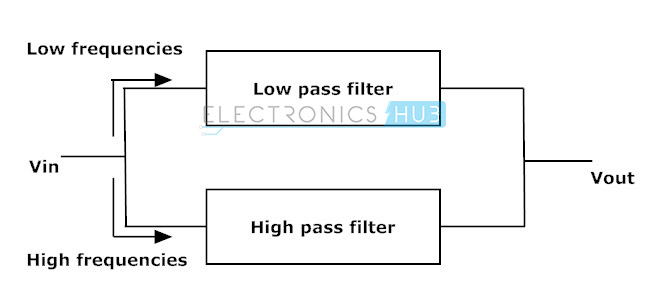
We know that unlike high pass and low pass filters, band pass and band stop filters have two cut-off frequencies. It will pass above and below a particular range of frequencies whose cut off frequencies are predetermined depending upon the value of the components used in the circuit design.
Any frequencies in between these two cut-off frequencies are attenuated. It has two pass bands and one stop band. The ideal characteristics of the Band pass filter are as shown below.
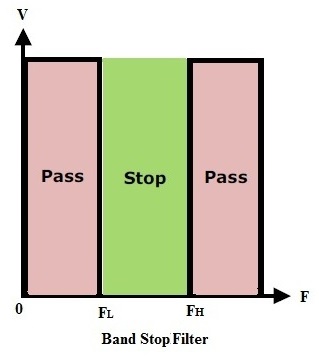
Where fL indicates the cut off frequency of the low pass filter.
fH is the cut off frequency of the high pass filter.
The centre frequencies fc = √( fL x fH)
The characteristics of a band stop filter are exactly opposite of the band pass filter characteristics.
When the input signal is given, the low frequencies are passed through the low pass filter in the band stop circuit and the high frequencies are passed through the high pass filter in the circuit.
In practice, due to the capacitor switching mechanism in the high pass and low pass filter the output characteristics are not same as that of in the ideal filter. The pass band gain must be equal to low pass filter and high pass filter. The frequency response of band stop filter is shown below and green line indicates the practical response in the below figure.
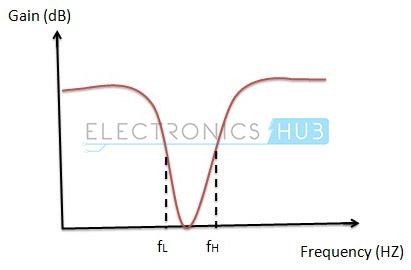
Band Stop Filter circuit using R, L and C
A simple band stop filter circuit with passive components is shown below.
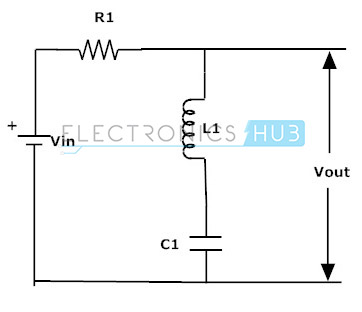
The output is taken across the inductor and capacitor which are connected in series. We know that for different frequencies in the input the circuit behaves either as an open or short circuit.
At low frequencies the capacitor acts as an open circuit and the inductor acts like a short circuit. At high frequencies the inductor acts like an open circuit and the capacitor acts like a short circuit.
Thus, by this we can say that at low and high frequencies the circuit acts like an open circuit because inductor and capacitor are connected in series. By this it is also clear that at mid frequencies the circuit acts like a short circuit. Thus the mid frequencies are not allowed to pass through the circuit.
The mid frequency range to which the filter acts as a short circuit depends on the values of lower and upper cut-off frequencies. This lower and upper cut-off frequency values depends on the component values.
These component values are determined by the transfer functions for the circuit according to the design. The transfer function is nothing but the ratio of the output to the input.

Where angular frequency ω = 2πf
Notch filter (Narrow band stop filter)
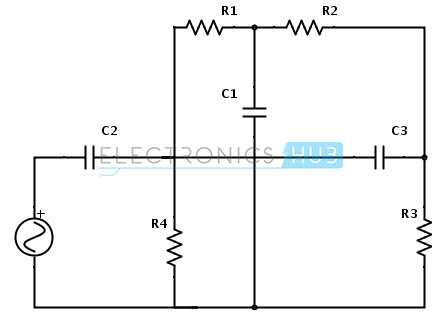
The above circuit shows the Twin ‘T’ network. This circuit gives us a notch filter. A notch filter is nothing but the narrow Band stop filter. The characteristic shape of the band stop response makes the filter as a notch filter.
This notch filter is applied to eliminate the single frequency. Since it consists of two ‘T’ shaped networks, it is referred as Twin T network. The maximum elimination is occurs at the centre frequency fC = 1/(2πRC).
In order to eliminate the specific value of the frequency in case of a notch filter, the capacitor chosen in the circuit design must be less than or equal to the 1 µF. By using the centre frequency equation,we can calculate the value of the resistor.
By using this notch circuit,we can eliminate single frequency at 50 or 60 Hz.
The second order notch filter with active component op-amp in non-inverting configuration is given as follows.
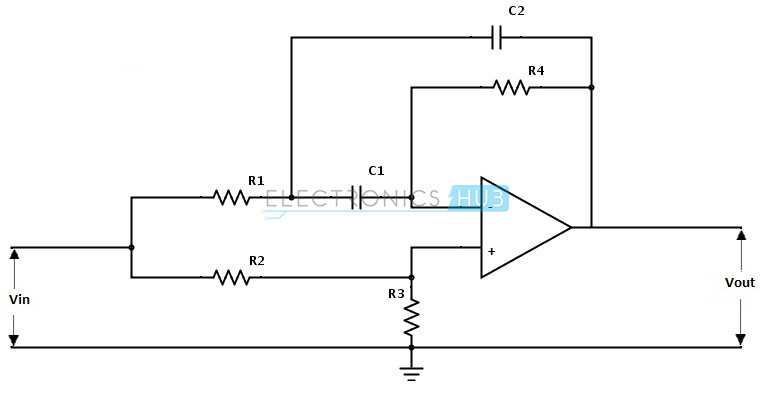
The gain can be calculated as

Where Quality factor Q = 1/ 2 x (2 – Amax)
If the value of the quality factor is high, then the width of the notch filter is narrow.
Frequency Response of the Band Stop Filter
By taking the frequency and gain, the frequency response of the stop band is obtained as below.
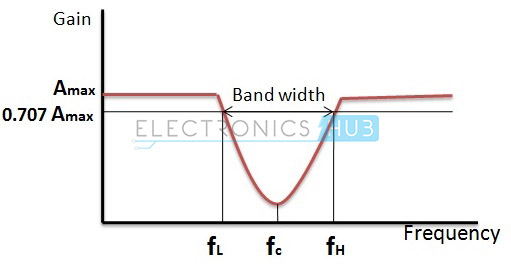
The bandwidth is taken across the lower and higher cut-off frequencies. According to ideal filter the pass band must have the gain as Amax and a stop band must have zero gain. In practice, there will be some transition region. We can measure the pass band ripple and stop band ripples as follows
Pass Band Ripple = – 20 log10(1-δp) dB
Stop Band Ripple = – 20 log10(δs) dB
Where
δp = Magnitude response of the pass band filter.
δs= Magnitude response of the stop band filter.
The typical stop bandwidth of the band stop filter is 1 to 2 decades. The highest frequency eliminated is 10 to 100 times the lowest frequencies eliminated.
Ideal response of the notch filter
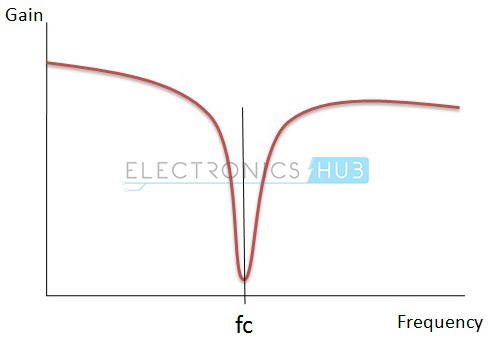
Band Stop Filter Example
Let us consider the narrow band notch filter circuit. We know that the notch filter is used to eliminate single frequency. Thus let us consider the frequency to eliminate be 120 Hz. The capacitor value C= 0.33 µF.
By using the centre frequency fC = 1/(2πRC)
R = 1/(2πfCC) = 1 / (2πx120 x 0.33 x 10-6) = 4 kΩ
Thus, in order design the notch filter to eliminate 120 Hz frequency we have to take two parallel resistors with 4 kΩ each and the two capacitors in parallel with 0.33 µF each.
Band Stop filter summary
Band Stop filter has two pass bands and one stop band. The characteristics of this filter are exactly opposite to the Band Pass Filter. It is also called as a Band rejection filteror Band elimination filter. It uses a high pass filter and a low pass filter connected in parallel. The low frequencies are given to the low pass, whereas the high frequencies are given to the high pass filter.
Simple RLC circuit by connecting capacitor and inductor in series forms the band stop filter. At very high and very low frequencies the band stop filter circuit acts like an open circuit, whereas at mid frequencies the circuit acts as a short circuit.
Hence, the circuit attenuates only mid frequencies and allows all other frequencies. The lower and higher cut-off frequencies of the filter depend on the filter design.
The Band Stop filter with narrow band stop features is called as a notch filter. It is used to eliminate single frequency value. It is formed by two resistors and two capacitors connected in two ‘T’ shaped networks.
So, it is referred as Twin ‘T’ filter. The bandwidth of the filter is nothing but the stop band of the filter. If the quality factor Q is high the narrow the width of the notch response. These are widely preferred in communication circuits.
Applications of Band Stop filter
In different technologies, these filters are used at different varieties.
- In telephone technology, these filters are used as the telephone line noise reducers and DSL internet services. It will help to remove the interference on the line which will reduce the DSL performance.
- These are widely used in the electric guitar amplifiers. Actually,this electric guitar produces a ‘hum’ at 60 Hz frequency. This filter is used to reduce that hum in order to amplify the signal produced by the guitar amplifier and makes the best equipment. These are also used in some of the acoustic applications like mandolin, base instrument amplifiers.
- In communication electronics the signal is distorted due to some noise (harmonics) which makes the original signal to interfere with other signals which lead to errors in the output. Thus, these filters are used to eliminate these unwanted harmonics.
- These are used to reduce the static on radio, which are commonly used in our daily life.
- These are also used in Optical communication technologies, at the end of the optical fiber there may be some interfering (spurious) frequencies of light which makes the distortions in the light beam. These distortions are eliminated by band stop filters. The best example is in Raman spectroscopy.
- In image and signal processing these filters are highly preferred to reject noise.
- These are used in high quality audio applications like PA systems (Public address systems).
- These are also used in medical field applications,i.e., in biomedical instruments like EGC for removing line noise.
The post Band Stop Filter appeared first on Electronics Hub.
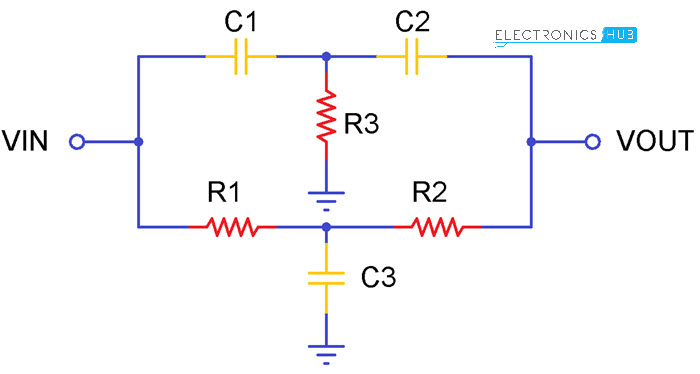
0 Comments